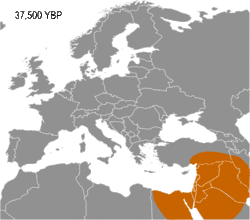Haplogroup C-V20
Haplogroup C-V20 (also known as Haplogroup C1a2) is a Y-chromosome haplogroup. It is one of two primary branches of Haplogroup C1a, one of the descendants of Haplogroup C1 (The other is C1a1 in Japan with an average amount of 5%[1]). Haplogroup C-V20 is now distributed in Europe, North Africa, West Asia, and South Asia with very low frequency.
| Haplogroup C-V20 | |
|---|---|
| Possible place of origin | West Asia |
| Ancestor | (Grandparent) C1 |
| Defining mutations | V20 |
| Highest frequencies | Very low frequency in Europe, North Africa, West Asia and South Asia |
History and Distribution
_2017.png.webp)

Haplogroup C1a2 (V20) has been discovered in the remains of Palaeolithic people in Czech Republic (30,000 years ago), Belgium (35,000 years ago),[3] and the Sunghir archaeological site near Vladimir, Russia.[4] Regarding more recent prehistory, Haplogroup C-V20 has been found in the remains of a male (died ca. 7,000 years ago) associated with a late group of the Alföld Linear Pottery culture at Kompolt-Kigyósér, Hungary whose mtDNA belonged to haplogroup J1c1, the remains of a male (died ca. 7,000 years ago) associated with the LBK Culture at Apc-Berekalja (I.), Hungary whose mtDNA belonged to haplogroup K1a3a3, and the remains of a male (died ca. 7,000 years ago) associated with Mesolithic culture at La Braña-Arintero, León, Spain whose mtDNA belonged to haplogroup U5b2c1.[5] It has also been found[6] in ancient DNA from Anatolia, specifically in the remains of an Anatolian hunter-gatherers dating from 13.642-13.073 BCE and belonging to mitochondrial haplogroup K2b.
Haplogroup C-V20 Y-DNA also has been found in a very small number of modern Europeans,[7] Algerians,[8] Armenians,[9] Turks and Nepalis.[10] It includes many Y-DNA samples associated with the oldest currently known population of anatomically modern humans in Europe (Cro-Magnons), and it is considered to be a carrier of the Upper Paleolithic Aurignacian culture that began 40,000 years ago.[11]
References
- 崎谷満『DNA・考古・言語の学際研究が示す新・日本列島史』(勉誠出版 2009年)(in Japanese)
- Currat, M.; Excoffier, L. (2004). "Modern Humans Did Not Admix with Neanderthals during Their Range Expansion into Europe". PLOS Biol. 2 (12): e421. doi:10.1371/journal.pbio.0020421. PMC 532389. PMID 15562317.
- Fu, Qiaomei; et al. (2016). "The genetic history of Ice Age Europe". Nature. 534 (7606): 200–5. Bibcode:2016Natur.534..200F. doi:10.1038/nature17993. hdl:10211.3/198594. PMC 4943878. PMID 27135931.
- Sikora, Martin; Seguin-Orlando, Andaine; Sousa, Vitor C.; Albrechtsen, Anders; Korneliussen, Thorfinn; et al. (2017). "Ancient genomes show social and reproductive behavior of early Upper Paleolithic foragers". Science. 358 (6363): 659–662. Bibcode:2017Sci...358..659S. doi:10.1126/science.aao1807. ISSN 0036-8075. PMID 28982795.
- ISOGG, 2015 "Y-DNA Haplogroup C and its Subclades – 2015" (15 September 2015).
- Krause, Johannes; Jeong, Choongwon; Haak, Wolfgang; Posth, Cosimo; Stockhammer, Philipp W.; Mustafaoğlu, Gökhan; Fairbairn, Andrew; Bianco, Raffaela A.; Julia Gresky (2019-03-19). "Late Pleistocene human genome suggests a local origin for the first farmers of central Anatolia". Nature Communications. 10 (1): 1218. Bibcode:2019NatCo..10.1218F. doi:10.1038/s41467-019-09209-7. ISSN 2041-1723. PMC 6425003. PMID 30890703.
- Scozzari, R; Massaia, A; D'Atanasio, E; Myres, NM; Perego, UA; et al. (2012). "Molecular Dissection of the Basal Clades in the Human Y Chromosome Phylogenetic Tree". PLOS ONE. 7 (11): e49170. Bibcode:2012PLoSO...749170S. doi:10.1371/journal.pone.0049170. PMC 3492319. PMID 23145109.
- ISOGG Y-DNA Haplogroup C and its Subclades - 2017 (Accessed August 26, 2017)
- YFull Haplogroup YTree v5.05 at 30 July 2017
- Hallast, Pille; Batini, Chiara; Zadik, Daniel; et al. (2014). "The Y-Chromosome Tree Bursts into Leaf: 13,000 High-Confidence SNPs Covering the Majority of Known Clades". Molecular Biology and Evolution. 32 (3): 661–673. doi:10.1093/molbev/msu327. PMC 4327154. PMID 25468874.
- Fu, Qiaomei; et al. (2016). "The genetic history of Ice Age Europe". Nature. 534 (7606): 200–5. Bibcode:2016Natur.534..200F. doi:10.1038/nature17993. hdl:10211.3/198594. PMC 4943878. PMID 27135931.